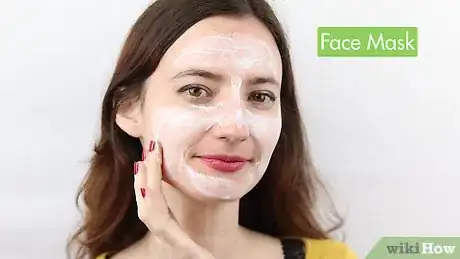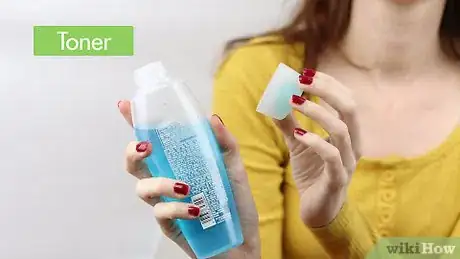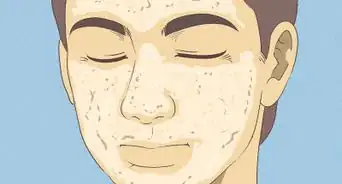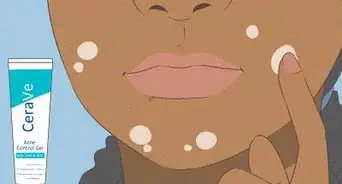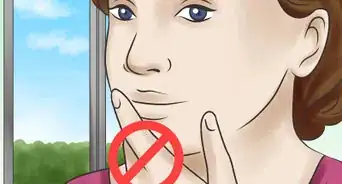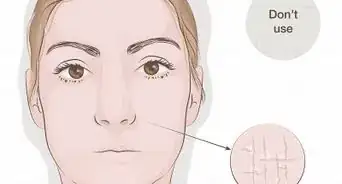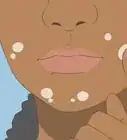This article was co-authored by Mohiba Tareen, MD. Mohiba Tareen is a board certified Dermatologist and the founder of Tareen Dermatology located in Roseville, Maplewood and Faribault, Minnesota. Dr. Tareen completed medical school at the University of Michigan in Ann Arbor, where she was inducted into the prestigious Alpha Omega Alpha honor society. While a dermatology resident at Columbia University in New York City, she won the Conrad Stritzler award of the New York Dermatologic Society and was published in The New England Journal of Medicine. Dr. Tareen then completed a procedural fellowship which focused on dermatologic surgery, laser, and cosmetic dermatology.
There are 25 references cited in this article, which can be found at the bottom of the page.
This article has been viewed 99,058 times.
Oily skin can feel uncomfortable and lead to blackheads and acne. Deciding which way to clean oily skin depends on your skin type, budget, and available time. Having a regular washing routine helps your skin be as clean as possible. Proper use of facial masks, oils, and moisturizing lotions will help you achieve clean, healthy skin.
Steps
Washing Your Face
-
1Choose a cleanser. Use a gentle face wash designed for oily skin. Liquid face washes containing alphahydroxy acids (AHAs), such as citric acid, lactic acid, or glycolic acid, exfoliate your skin and remove dead skin cells. Cleansers with emollients (petrolatum, lanolin, mineral oil, and ceramides) or humectants (glycerin) hold moisture in your skin. If you have acne, use medicated cleansers that contain salicylic acid, sodium sulfacetamide, or benzoyl peroxide. These ingredients fight acne while cleaning your skin.[1]
- Salicylic acid clears blocked pores and reduces swelling and redness.
- Benzoyl peroxide is an exfoliator and kills bacteria.
- Sodium sulfacetamide fights the growth of bacteria.[2]
-
2Wash your face twice daily with warm water. First, clean your hands. Wet your face with lukewarm water. Apply cleanser with your fingertips.[3] Gently cleanse your skin--do not scrub it harshly.[4] When you wake up and before you go to bed are ideal times to wash. Also be sure to wash after exercising or sweating profusely. You can wash over the sink or while showering. The shower acts as a giant steamer, opening your pores and liquefying sebum--your skin's oil.[5]
- Do not scrub your face too hard.[6] Also, do not use water that is too hot. Sebum is meant to lubricate your skin and protect it.[7]
- Use an exfoliator once or twice a week to remove dead skin cells and keep your pores open.[8] On the other hand, using a washcloth or buff puff can increase oiliness.[9]
- If you wear make-up, cleansing is better than using makeup remover wipes. If you must use a wipe, avoid products with alcohol and fragrances. Choose products designed for sensitive skin. If you have acne, buy wipes containing salicylic acid or do not use wipes at all.[10] Regardless, be sure to wash your face afterwards. Wipes are not a substitute for washing. Coconut oil is an effective, moisturizing, natural product for makeup removal.[11]
Advertisement -
3Pat your face dry with a clean towel. If possible, change your face towels every day. Oil, dirt, and bacteria get trapped on your towels. It is essential that you do not transfer these things back to yourself. Use a smaller sized hand towel or washcloth to reduce laundry.
-
4Moisturize your skin. After you wash and dry your face, it is important to apply an oil-free moisturizer. Even oily skin needs to be moisturized. Vary the amount you use based on how oily your skin feels.[12] Minimize the amount of moisturizer you use on your oiliest areas.
Cleaning Your Face with Topical Treatments
-
1Use a face mask. Once weekly, apply a drying mud or clay mask to your face. Mud or clay masks absorb excess oil from your skin and tone and tighten your pores.[13] While green clays absorb more oil, white clays are better for sensitive skin.[14] Egg-white masks also can firm your skin and soak up excess oil.[15] Lemon juice and mango are common ingredients for face masks.
- You can purchase masks in health stores or make your own. For one type of homemade mask, use facial clay (like bentonite) and witch hazel. Do not use pottery clay. Add one tablespoon witch hazel to one teaspoon facial clay; stir until they are blended. Additionally, add two drops cypress oil and two drops lemon oil for fragrance and to help control overactive oil glands. Relax and wear the mask for ten minutes or until the clay is dry. Rinse it off.[16]
-
2Apply natural oils. Although it might seem counterintuitive to apply oil to your face, some natural products like argan, coconut, or jojoba oil can reduce oiliness. By applying oil, you can trick your skin into thinking it already has produced enough oil. Using oil then stabilizes your body's oil production.[17]
- A mixture of lavender and neroli essential oils (derived from orange blossoms) can act as a skin cleanser and toner. Tea tree oil is also effective at reducing oily skin.[18]
-
3Utilize a toner. Non-alcohol toners help tighten your pores. Although toners are not essential to a skincare regimen, they help many people. You can purchase toners in drugstores or make your own. Use toners after you wash your face. Soak a cotton pad in the toner and dab it on your face. Use it twice daily for two to three weeks. After week three, apply it once daily. Be sure to use the toner only on the oily parts of your face (e.g. forehead, nose, and chin).[19]
- You can make your own toners at home. Toners restore the skin's natural pH balance, which hard water can disrupt. Witch hazel, thyme, lavender, sandalwood, cucumber, and basil are all effective toner ingredients.[20]
Improving Your Lifestyle
-
1Eat healthy foods. Hormonal reactions based on your diet and lifestyle trigger oil production.[21] Reduce processed foods in your diet. Eat more fruits and vegetables and drink lots of water. You might consider reducing your dairy intake because milk product hormones impact acne and oil production.[22] Eating excess carbohydrates also causes increased acne [23]
- Take one tablespoon of flaxseed oil daily. Flaxseed oil helps produce natural oil, reducing the need for excess oil production.
-
2Exercise more. Increased blood flow from aerobic exercise should help your skin. Incorporate walking, running, or biking into your daily routine.[24] Exercise also can help reduce stress by producing endorphins.[25] If you exercise outdoors, your skin also will benefit from receiving sufficient Vitamin D.
-
3Reduce stress levels. Stress can increase levels of the stress hormone cortisol. Higher cortisol levels lead to increased oil production.[26] Take the time to relax and meditate. Exercising or wearing a face mask can reduce stress and oiliness. Also be sure to sleep enough so that your skin looks its best.
-
4Finished.
Expert Q&A
Did you know you can get expert answers for this article?
Unlock expert answers by supporting wikiHow
-
QuestionWhat kind of face wash will help with oily skin?
 Mohiba Tareen, MDMohiba Tareen is a board certified Dermatologist and the founder of Tareen Dermatology located in Roseville, Maplewood and Faribault, Minnesota. Dr. Tareen completed medical school at the University of Michigan in Ann Arbor, where she was inducted into the prestigious Alpha Omega Alpha honor society. While a dermatology resident at Columbia University in New York City, she won the Conrad Stritzler award of the New York Dermatologic Society and was published in The New England Journal of Medicine. Dr. Tareen then completed a procedural fellowship which focused on dermatologic surgery, laser, and cosmetic dermatology.
Mohiba Tareen, MDMohiba Tareen is a board certified Dermatologist and the founder of Tareen Dermatology located in Roseville, Maplewood and Faribault, Minnesota. Dr. Tareen completed medical school at the University of Michigan in Ann Arbor, where she was inducted into the prestigious Alpha Omega Alpha honor society. While a dermatology resident at Columbia University in New York City, she won the Conrad Stritzler award of the New York Dermatologic Society and was published in The New England Journal of Medicine. Dr. Tareen then completed a procedural fellowship which focused on dermatologic surgery, laser, and cosmetic dermatology.
FAAD Board Certified Dermatologist
Warnings
- If you have acne, do not attempt to pop your pimples. This can lead to scarring.⧼thumbs_response⧽
- Some skin treatments contain harsh chemicals so read labels carefully and follow instructions accordingly.⧼thumbs_response⧽
- Avoid using heavy, liquid cosmetics that contain mineral oil, fragrances, and parabens. Oil-free mineral-based makeup is best for oily skin.[29]⧼thumbs_response⧽
- Benzoyl peroxide can be too drying and it may bleach your clothes. Using a benzoyl peroxide wash instead of a leave-on cream can help prevent these issues.[30]⧼thumbs_response⧽
References
- ↑ http://www.webmd.com/skin-problems-and-treatments/acne/cleansers
- ↑ http://www.webmd.com/skin-problems-and-treatments/acne/cleansers
- ↑ https://www.aad.org/dermatology-a-to-z/health-and-beauty/general-skin-care/face-washing-101
- ↑ http://www.laroche-posay.com/article/peaux-grasses/a313.aspx
- ↑ http://www.womenshealthmag.com/beauty/washing-your-face
- ↑ http://www.webmd.com/beauty/face/20050222/how-to-get-most-out-of-facial-cleaning
- ↑ http://www.mayoclinic.org/diseases-conditions/acne/basics/causes/con-20020580
- ↑ http://www.webmd.com/skin-problems-and-treatments/acne/cleansers?page=2
- ↑ http://www.webmd.com/skin-problems-and-treatments/acne/features/oily-skin
- ↑ http://www.dailymail.co.uk/femail/article-2582298/Will-cleansing-wipes-wreck-looks.html
- ↑ http://www.allure.com/beauty-trends/blogs/daily-beauty-reporter/2015/03/coconut-oil-makeup-remover.html
- ↑ http://www.webmd.com/skin-problems-and-treatments/acne/features/oily-skin?page=2
- ↑ https://www.allure.com/story/right-way-to-use-clay-face-mask
- ↑ http://www.holistichealthherbalist.com/white-kaolin-clay/
- ↑ http://homemademasks.net/face-mask/by-problem/acne/egg-white-face-mask-lemon-oily-skin-acne/
- ↑ http://www.besthealthmag.ca/best-you/home-remedies/natural-home-remedies-oily-skin#xU0Apc5OMW2F4Gil.99
- ↑ http://www.wellnesstoday.com/beauty/15-surprising-beauty-uses-for-jojoba-oil
- ↑ http://www.cosmopolitan.co.uk/beauty-hair/news/a36363/best-oils-to-fight-oily-skin-and-breakouts-yes-really/
- ↑ http://www.webmd.com/skin-problems-and-treatments/acne/features/oily-skin
- ↑ http://naturalfacialrecipes.homestead.com/tonerrecipes.html
- ↑ http://www.precisionnutrition.com/all-about-acne-nutrition
- ↑ https://www.the-dermatologist.com/article/7575
- ↑ http://www.mayoclinic.org/diseases-conditions/acne/basics/causes/con-20020580
- ↑ http://www.sheknows.com/beauty-and-style/articles/6588/lifestyle-habits-for-healthier-skin
- ↑ http://www.sciencedaily.com/releases/2007/11/071109194053.htm
- ↑ http://www.sciencedaily.com/releases/2007/11/071109194053.htm
- ↑ Mohiba Tareen, MD. Board Certified Dermatologist. Expert Interview. 26 March 2020.
- ↑ http://www.webmd.com/skin-problems-and-treatments/acne/features/oily-skin?page=3
- ↑ http://www.webmd.com/beauty/makeup/the-lowdown-on-mineral-makeup?page=2
- ↑ Mohiba Tareen, MD. Board Certified Dermatologist. Expert Interview. 26 March 2020.

